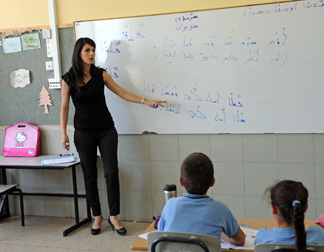Maronites in Israel Learn Aramaic
 Fourth-grade teacher Mona Issa teaches the Aramaic
language class at Jish Elementary School in Jish,
Israel, 20 June. The mostly Maronite Catholic
community is trying to revive the Aramaic language
that was spoken by Jesus. (photo: CNS/Debbie Hill)
Fourth-grade teacher Mona Issa teaches the Aramaic
language class at Jish Elementary School in Jish,
Israel, 20 June. The mostly Maronite Catholic
community is trying to revive the Aramaic language
that was spoken by Jesus. (photo: CNS/Debbie Hill)
25 Jun 2012 – by Judith
Sudilovsky
JISH, Israel (CNS) — Aramaic language classes begun
four years ago at Jish Elementary School have changed
the way youngsters experience the weekly liturgy.
“Before, I used to wonder how I would get through the
one-and-a-half hours at church. Sometimes we would even
laugh at the how the priest was praying,” recalled Carla
Issa, 9, who has studied Aramaic at the school for two
years. “But now I understand what I am saying. I love
it.”
Sunday Mass at St. Maron Parish is partially recited
in Aramaic. But Issa and friends also have found another
use for the ancient language: They sometimes use it when
they pass notes to each other in class.
Some 110 students are now studying the language at
the elementary school as a result of years of effort by
village resident Shadi Khalloul, 37, chairman of the
Aramaic Christian nongovernmental organization in
Israel.
“This is our Maronite Aramaic heritage,” he said on a
recent visit to the school. “We are hoping to revive (Aramaic)
as a spoken language. Hopefully the pupils will use it
among themselves to communicate with each other. It is
our forefather’s language. It is the language of Jesus,
we should not forget that, especially the Aramaic
Galilee dialect.”
Spoken Aramaic, the root language of all Semitic
languages, is still preserved in parts of Syria, Iraq
and Lebanon — and even by elderly Jews originating from
a region of Kurdistan — but the spoken language has been
virtually lost in Galilee, where about 10,000 Maronite
Catholics use it solely for prayer. During their daily
interactions, they speak Arabic.
In all, there are between half a million and 1
million people worldwide who still use Aramaic as their
vernacular language, while another 15 million use it
only as a holy language, said Khalloul.
In Jish some older residents like Issa's grandfather,
who helped her with her homework when she started
studying, have retained their traditional language, but
most Maronites of the village only hear Aramaic on
Sundays.
Aramaic is taught regularly as part of religion
classes by Father Bishara Suleiman, but it was not until
the priest offered a three-month course for adults in
2006 that Khalloul, who had recently returned to Jish
after graduating from the University of Nevada, became
hooked on the language. A small group of adult students
continued studying on their own following the conclusion
of the course and began connecting with other Aramaic
communities in Sweden and the Netherlands.
Khalloul initiated his own after-school classes for
youngsters, then started to negotiate with the Israeli
Ministry of Education to include Aramaic as part of the
formal curriculum.
The ministry now provides funds for the classes
through the eighth grade as part of any enrichment
program already in place. For now, it is the only such
project in Israel. A parallel art class is offered
during the same period, but almost 90 percent of the
Christian children choose to attend the Aramaic classes,
said school principal Reem Khatieb-Zuabi, a Muslim woman.
She said classes have proven to be a matter of pride
for the school, and even some Muslim students are taking
the class.